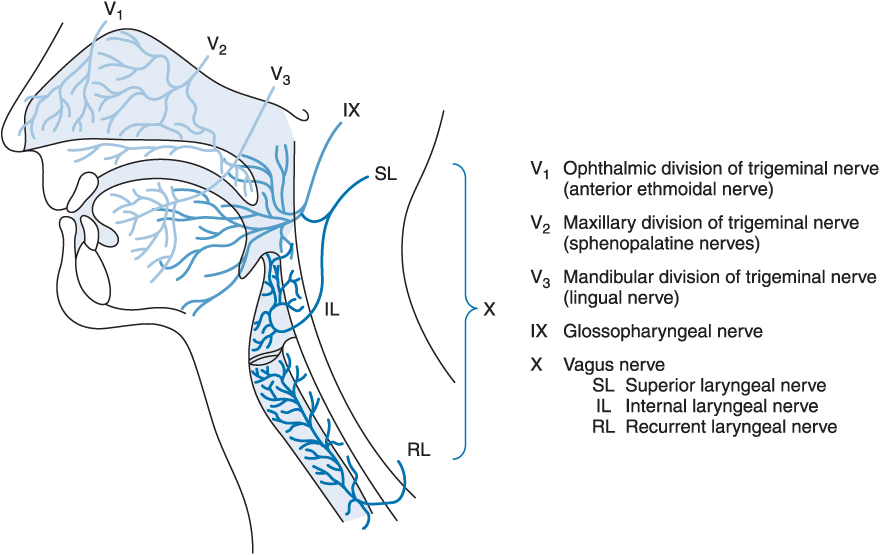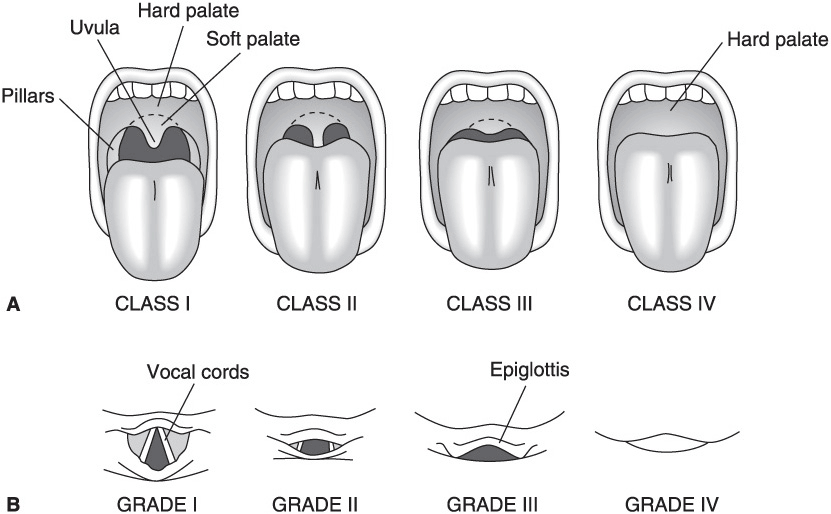1. Sensory innervation: The trigeminal nerve divisions innervate the nose. The lingual nerve (branch of trigeminal nerve V3) and glossopharyngeal nerve provide sensation to the anterior two-thirds and posterior third of the tongue, respectively. Branches of the vagus nerve provide sensation below the epiglottis. The internal superior laryngeal nerve (SLN) branch provides sensation to the larynx between the epiglottis and vocal cords. The recurrent laryngeal nerve (RLN) branch innervates the larynx below the vocal cords and trachea.
2. Motor innervation: The RLN innervates all larynx muscles except the cricothyroid muscle, which is innervated by the external branch of the SLN. The posterior cricoarytenoid muscles abduct the vocal cords while the lateral cricoarytenoid muscles adduct.
3. Paralysis: Unilateral SLN denervation has little clinical effect. Bilateral SLN palsy results in hoarseness. Unilateral RLN paralysis results in deterioration in voice quality. However, acute bilateral RLN palsy can lead to stridor and respiratory distress. Chronic RLN denervation can lead to aphonia without airway compromise caused by compensatory mechanisms.

Airway Assessment
1. Mouth opening: Incisor distance of 3 cm or greater in adults.
2. Upper lip bite test: Lower teeth brought in front of upper teeth to test range of motion of temporomandibular joints.
3. Mallampati classification: The greater the tongue obstructs the view of the pharyngeal structures, the more difficult the intubation may be
I. Entire palatal arch is visible
II. Upper part of faucial pillar and most of uvula are visible
III. Only soft and hard palate are visible
IV. Only hard palate is visible
4. Thyromental distance: Greater than 3 fingerbreadths is desirable.
5. Neck circumference: Greater than 27 inches suggests difficulty in visualizing glottic opening.
Mallampati Classification

(Reproduced, with permission, from Mallampati SR: Clinical signs to predict difficult tracheal intubation [hypothesis]. Can Anaesth Soc J 1983;30:316.)
Equipment
Oral and nasal airways: Anesthetized patients lose upper airway muscle tone, causing the tongue and epiglottis to fall back against the posterior pharynx. An artificial airway can maintain air passage. Awake or lightly anesthetized patients can develop laryngospasm during insertion. Avoid nasal airways in anticoagulated patients, as well as patients with basilar skull fractures.
Bag and mask ventilation (BMV): Effective mask ventilation requires a gas-tight mask fit and a patent airway. Limit positive-pressure ventilation to 20 cm H2O to avoid stomach inflation. The mask is in the operator’s left hand with the face lifted into the mask by the third, fourth, and fifth digits. If ventilation is ineffective, place an oral or nasal airway. Difficult mask ventilation is seen in patients with beards, morbid obesity, and craniofacial deformities. Prolonged mask ventilation may lead to damage of trigeminal and facial nerves.
Supraglottic airway devices (SADs): SADs consist of a hypopharyngeal cuff, which seals and directs airflow to the glottis, trachea, and lungs, as well as a tube that connects to the respiratory circuit or breathing bag. Laryngeal mask airways (LMA), a type of SAD, provide a low-pressure seal around the larynx. There are a variety of designs, but none offers the same protection from aspiration pneumonitis as a cuffed endotracheal tube. Contraindications to LMAs include pharyngeal pathology, pharyngeal obstruction, full stomachs, and low pulmonary compliance requiring peak inspiratory pressures greater than 30 cm H2O. LMAs are an important aspect of the difficult airway algorithm because of their ease of insertion and ability to act as a conduit for endotracheal intubation.
Tracheal tubes (TTs): Most adult TTs have a cuff, creating a tracheal seal to permit positive-pressure ventilation and reduce aspiration. High-pressure (low-volume) or low-pressure (high-volume) cuffs may be used. High-pressure cuffs are associated with more tracheal ischemia; low-pressure cuffs cause more sore throats, aspiration, and difficult insertions. Cuff pressure may rise with nitrous oxide general anesthesia because of diffusion of gas into the cuff.
Stay updated, free articles. Join our Telegram channel

Full access? Get Clinical Tree





